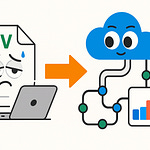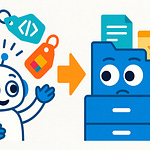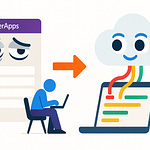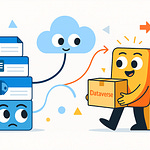It’s 1975. You’re staring at a beige metal box called the Altair 8800. To make it do anything, you flip tiny switches and wait for blinking lights. By the end of this video, you’ll see how those same design habits translate into practical value today—helping you cost‑optimize, automate, and reason more clearly about Microsoft 365, Power Platform, and Azure systems.
Fast forward to today—you click once, and Azure spins up servers, runs AI models, and scales to thousands of users instantly. The leap looks huge, but the connective tissue is the same: resource sharing, programmable access, and network power. These are the ideas that shaped then, drive now, and set up what comes next.
The Box with Switches
So let’s start with that first box of switches—the Altair 8800—because it shows us exactly how raw computing once felt. What could you actually do with only a sliver of memory and a row of toggle switches? At first glance, not much. That capacity wouldn’t hold a single modern email, let alone an app or operating system. And the switches weren’t just decoration—they were the entire interface. Each one represented a bit you had to flip up or down to enter instructions. By any modern measure it sounds clumsy, but in the mid‑1970s it felt like holding direct power in your hands.
The Altair arrived in kit form, so hobbyists literally wired together their own future. Instead of booking scarce time on a university mainframe or depending on a corporate data center, you could build a personal computer at your kitchen table. That was a massive shift in control. Computing was no longer locked away in climate‑controlled rooms; it could sit on your desk. Even if its first tricks were limited to blinking a few lights in sequence or running the simplest programs, the symbolism was big—power was no longer reserved for institutions.
By today’s standards, the interface was almost laughable. No monitor, no keyboard, no mouse. If you wanted to run a program, you punched in every instruction by hand. Flip switches to match the binary code for one CPU operation, press enter, move to the next step. It was slow and completely unforgiving. One wrong flip and the entire program collapsed. But when you got it right, the front‑panel lights flickered in the exact rhythm you expected—that was your proof the machine was alive and following orders.
That act of watching the machine expose its state in real time gave people a strange satisfaction. Every light told you exactly which memory location or register was active. Nothing was abstracted. You weren’t buried beneath layers of software; instead, you traced outcomes straight back to the switches you’d set. The transparency was total, and for many, it was addictive to see a system reveal its “thinking” so directly.
Working under these limits forced a particular discipline. With only a few hundred bytes of usable space, waste wasn’t possible. Programmers had to consider structure and outcome before typing a single instruction. Every command mattered, and data placement was a strategic decision. That pressure produced developers who acted like careful architects instead of casual coders. They were designing from scarcity. For you today, that same design instinct shows up when you choose whether to size resources tightly, cache data, or even decide which connector in Power Automate will keep a flow efficient. The mindset is the inheritance; the tools simply evolved.
At a conceptual level, the relationship between then and now hasn’t changed much. Back in 1975, the toggle switch was the literal way to feed machine code. Now you might open a terminal to run a command, or send an HTTP request to move data between services. Different in look, identical in core. You specify exactly what you want, the system executes with precision, and it gives you back a response. The thrill just shifted form—binary entered by hand became JSON returned through an API. Each is a direct dialogue with the machine, stripped of unnecessary decoration.
So in one era, computing power looked like physical toggles and rows of LEDs; in ours, it looks like REST calls and service endpoints. What hasn’t changed is the appeal of clarity and control—the ability to tell a computer exactly what you want and see it respond. And here’s where it gets interesting: later in this video, I’ll show you both a working miniature Altair front panel and a live Azure API call, side by side, so you can see these parallels unfold in real time.
But before that, there’s a bigger issue to unpack. Because if personal computers like the Altair were supposed to free us from mainframes, why does today’s cloud sometimes feel suspiciously like the same centralized model we left behind?
Patterns That Refuse to Die
Patterns that refuse to die often tell us more about efficiency than nostalgia. Take centralized computing. In the 1970s, a mainframe wasn’t just the “biggest” machine in the room—it was usually the only one the entire organization had. These systems were large, expensive to operate, and structured around shared use. Users sat at terminals, which were essentially a keyboard and a screen wired into that single host. Your personal workstation didn’t execute programs. It was just a window into the one computer that mattered.
That setup came with rules. Jobs went into a queue because resources were scarce and workloads were prioritized. If you needed a report or a payroll run, you submitted your job and waited. Sometimes overnight. For researchers and business users alike, that felt less like having a computer and more like borrowing slivers of one.
This constraint helped accelerate interest in personal machines. By the mid‑1970s, people started talking about the freedom of computing on your own terms. The personal computer buzz didn’t entirely emerge out of frustration with mainframes, but the sense of independence was central. Having something on your desk meant you could tinker immediately, without waiting for an operator to approve your batch job or a printer to spit out results hours later. Even a primitive Altair represented autonomy, and that mattered.
The irony is that half a century later, centralization isn’t gone—it came back, simply dressed in new layers. When you deploy a service in Azure today, you click once and the platform decides where to place that workload. It may allocate capacity across dozens of machines you’ll never see, spread across data centers on the other side of the world. The orchestration feels invisible, but the pattern echoes the mainframe era: workloads fed into a shared system, capacity allocated in real time, and outcomes returned without you touching the underlying hardware.
Why do we keep circling back? It’s not nostalgia—it’s economics. Running computing power as a shared pool has always been cheaper and more adaptable than everyone buying and maintaining their own hardware. In the 1970s, few organizations could justify multiple mainframes, so they bought one and shared it. In today’s world, very few companies want to staff teams to wire racks of servers, track cooling systems, and stay ahead of hardware depreciation. Instead, Azure offers pay‑as‑you‑go global scale.
For the day‑to‑day professional, this changes how success is measured. A product manager or IT pro isn’t judged on how many servers stay online—they’re judged on how efficiently they use capacity. Do features run dependably at reasonable cost? That’s a different calculus than uptime per box. Multi‑tenant infrastructure means you’re operating in a shared environment where usage spikes, noisy neighbors, and resource throttling exist in the background. Those trade‑offs may be hidden under Azure’s automation, but they’re still real, and your designs either work with or against them.
This is the key point: the cloud hides the machinery but not the logic. Shared pools, contention, and scheduling didn’t vanish—they’ve just become transparent to the end user. Behind a function call or resource deployment are systems deciding where your workload lands, how it lives alongside another tenant’s workload, and how power and storage are balanced. Mainframe operators once managed these trade‑offs by hand; today, orchestration software does it algorithmically. But for you, as someone building workflows in Microsoft 365 or designing solutions on Power Platform, the implication is unchanged—you’re not designing in a vacuum. You’re building inside a shared structure that rewards efficient use of limited resources.
Seen this way, being an Azure customer isn’t that different from being a mainframe user, except the mainframe has exploded in size, reach, and accessibility. Instead of standing in a chilled machine room, you’re tapping into a network that stretches across the globe. Azure democratizes the model, letting a startup with three people access the same pool as an enterprise with 30,000. The central patterns never really died—they simply scaled.
And interestingly, the echoes don’t end with the architecture. The interfaces we use to interact with these shared systems also loop back to earlier eras. Which raises a new question: if infrastructure reshaped itself into something familiar, why did an old tool for talking to computers quietly return too?
The Terminal Renaissance
Why are so many developers and administrators still choosing to work inside a plain text window when every platform around them offers polished dashboards, AI copilots, and colorful UIs? The answer is simple: the terminal has evolved into one of the most reliable, efficient tools for modern cloud and enterprise work. That quiet scrolling screen of text remains relevant because it does something visual tools can’t—give you speed, precision, and automation in one place.
If you’ve worked in tech long enough, you know the terminal has been part of the landscape since the 1970s. Back then, text interfaces were the only way you could interact with large systems. They were stripped down—no icons, no menus—just direct instructions. When personal computers popularized graphical interfaces in the 1990s, the command line briefly felt like a relic. The future looked like endless windows, buttons, and drag‑and‑drop. But over time, the divide between GUIs and terminals clarified: graphical interfaces win for discoverability, while terminals win for precision and repeatability. That tradeoff is exactly why the terminal quietly staged its return.
Look at how people work in cloud environments today. Developers move code with Git commands every day. Admins write PowerShell scripts to batch‑process changes that would take hours by hand. Azure engineers use CLI tools to provision resources because typing a single command and watching it run beats waiting for a web portal to load page after page of options. And in this video, I’ll show you one of those moments myself: an Azure CLI call that provisions a resource in seconds. Watch the output stream across the terminal, complete with logs you can trace back line by line. That’s not nostalgia—it’s direct evidence of why the terminal survives.
Consider a practical example. Imagine your team generates the same report for compliance every Monday. Doing it by hand through menus means lots of repetitive clicks, multiple sign‑ins, and human error if someone misses a step. With a short script or a scheduled flow, the work compresses into one reliable task that doesn’t care if it runs ten times or a thousand times. This is where the terminal links back to the earlier era: when the Altair forced you to flip physical switches with absolute clarity, there was no room for wasted motion. Scripted commands live in the same spirit—no wasted steps, no guesswork, just instruction and outcome.
The attraction scales with complexity. Suppose you’re rolling out hundreds of policies across tenants in Microsoft 365, or setting up multiple environments in Azure. Doing that by hand in a dashboard means navigating through endless dropdowns and wizards. A script can cut that process to a single repeatable file. It saves time, ensures accuracy, and allows you to test or share it with teammates. A screenshot of a mouse click isn’t transferable; a script is. This transparency is why text wins when accountability matters. Error logs in a terminal tell you exactly what failed and why, while graphical tools often reduce failures to vague pop‑ups.
What also makes the terminal effective is its role in collaboration. In large-scale cloud environments, one person’s workflow quickly becomes a template for the entire team. Sharing a text snippet is easy, portable, and fast to document. If the team wants to troubleshoot, they can run the exact same command and replicate the issue, something no slideshow of GUI clicks can reliably achieve. That shared language of text commands creates consistency across teams and organizations.
This doesn’t mean the graphical layer is obsolete. GUIs are excellent for learning, exploration, and visualizing when you aren’t sure what you’re looking for. But once you know what you want, the terminal is the shortest path between intention and execution. It offers certainty in a way that icons never will. That’s why professionals across Microsoft 365, Power Platform, and Azure keep it in their toolkit—it matches the scale at which modern systems operate.
So the terminal never truly disappeared; it evolved into a backbone of modern systems. AI copilots can suggest commands and dashboards can simplify onboarding, but when deadlines are tight and environments scale, it’s the command line that saves hours. Which leads to a deeper realization: tools matter, but the tool alone doesn’t determine success. What really carries across decades is a type of thinking—a way of translating complex ideas into clear, structured instructions. And that raises the question that sits underneath every era of computing: what human skill ties all of this together, regardless of the interface?
People and the Hidden Soft Skills
Success in computing has always relied on more than tools or interfaces—it’s shaped by how people think and work together. And that brings us to the human side of the story: the hidden soft skills that mattered in the 1970s and still matter when you’re building modern solutions in Microsoft 365, Power Platform, or Azure today.
For the Altair hobbyist, the main challenge wasn’t wiring the hardware—it was translating an idea into the smallest possible set of steps the computer could understand. Every instruction had to be broken down, mapped in binary, and entered manually. That process sharpened the ability to move from vague thoughts to strict flows. What survived over the decades isn’t the switches—it’s that discipline of turning intention into structure.
On the surface, today feels easier. You can spin up a connector in Power Automate, pull in an SDK, or let an AI suggest code on your behalf. But the core dilemma hasn’t disappeared: do you actually know what you want the system to do? Machines, whether Altair or Azure, can only follow the instructions you give them. AI-generated code or a workflow template often falls apart when the underlying intent isn’t clear. It’s a reminder that power doesn’t replace precision—it amplifies it.
This is where systems thinking remains the real differentiator. It’s not about syntax; it’s about seeing connections, boundaries, and flows. If you’ve built a business process in Power Platform, you know dragging shapes onto a canvas isn’t enough. The job is making sure those shapes line up into a flow that reliably matches your goal. The exercise is the same one someone with an Altair went through decades ago: design carefully before execution.
Collaboration makes the challenge even trickier. In the 1970s, dozens of users shared the same mainframe, so one poorly structured job could affect everyone. Now, global teams interact across tenants, regions, and services, and a decision in one corner can ripple through the rest of the system. That makes communication as critical as technical accuracy. You can’t just build—you have to explain, document, and make sure others can reuse and extend what you’ve delivered.
Often, the real problem isn’t in the compute layer at all—it’s in the human layer. We’ve all seen what happens when a workflow, script, or pipeline gets built, but the documentation is scattered and no one can track what’s running or why. The servers hum without issue, yet people can’t find context or hand work off smoothly. That’s where breakdowns still happen, just as they did when stacks of punched cards got misfiled decades ago.
So when conversations turn to “future skills,” it’s tempting to focus entirely on hard technical abilities: new coding languages, frameworks, or certifications. But those are the pieces that change every few years. What doesn’t change is the need to model complex processes, abstract where needed, and communicate intent in a way that scales beyond yourself. These are design habits as much as technical habits. Writing for the Altair forced developers into that mindset. Building for the cloud demands it just as much.
If anything, modern tools tilt the balance further toward the so‑called soft skills. The barriers that used to block you—installing servers, patching systems, building features from scratch—keep shrinking. Managed services and copilots absorb much of that work. What can’t be automated is judgment: deciding when one approach is more efficient than another, articulating why a design matters, and collaborating effectively across boundaries. That blend of clarity, structure, and teamwork is what underpins success now.
Here’s one simple and immediate way to practice it: before you build any automation this week, stop for one minute. Write a single sentence that defines your acceptance criteria, and choose one metric you’ll measure—like minutes saved or errors reduced. That quick habit forces precision before you even touch the tool, and over time it trains the same kind of systems thinking people once relied on when they had nothing but switches and blinking lights.
Computing may have come a long way, but the timeless skill isn’t tied to syntax or hardware—it’s about shaping human intent into something a machine can execute, and making sure others can work with it too. And once you see that pattern, it raises a new connection worth exploring: the way interface design itself has traveled full circle, from the rawest toggles to the APIs that power nearly everything today.
From Switches to APIs
From here the conversation shifts toward how we actually tell machines what to do. That trail runs straight from rows of physical switches in the 1970s to the APIs driving today’s cloud platforms. At first glance, those two realities couldn’t feel more different. One was slow, physical, and manual; the other is remote, automated, and globally distributed. But underneath, the same exchange is happening: a precise instruction goes in, something measurable comes back out.
Back on the Altair, the switches weren’t decorative—they were the most literal form of a programmable interface. Each position, up or down, directly controlled a bit flowing through the CPU. Metaphorically, you can think of those switches as the earliest style of “API call.” The programmer expressed intent by setting physical states, pressed a button, and got the machine to respond. Primitive, yes—but clear. The distance between human and hardware was almost nonexistent.
Over time that raw clarity was wrapped with more accessible layers. Instead of flipping binary patterns, people typed commands in BASIC. Instead of raw opcodes, you wrote “PRINT” or “IF…THEN” and let the interpreter handle the translation. Later the command line stepped in as the next progression. And now, decades on, REST APIs dominate how we issue instructions. The request‑response loop is fundamentally the same: you declare an intent in structured form, the system executes, and it delivers a result. The wrapping changed—but the contract never really did.
When you send a modern API call, you’re still doing conceptually what those early hobbyists did, just scaled to a wildly different level. Instead of one instruction toggled into a register, you fire off a JSON payload that travels across networks, lands in a data center, and orchestrates distributed services in seconds. The scope has exploded, but you’re still asking the system to follow rules, and you’re still waiting for a response.
On the Altair, loading even a small routine by flipping switches could take significant time. Each instruction demanded precise attention. Today, a single API request can provision virtual machines, configure storage, wire security, and stream confirmation in less time than it once took to punch in a few opcodes. If you want, you could even demonstrate this side by side: watch how long it takes to toggle just one short instruction sequence on a panel, then watch an Azure API spin up entire resources in the span of that same moment. It’s a visual reminder of scale built on the same roots.
Where the two diverge most is visibility. The Altair was transparent—you could literally watch every state change across its blinking lights. Modern APIs conceal that inner rhythm. Instead of lights, you’re left with logs, traces, and structured error messages. That’s all you get to stitch together what happened. More muscle at scale, less real‑time feedback of what’s happening under the covers. That tradeoff is worth noting because it changes how you design practical workflows.
For anyone working in Microsoft 365 or Power Platform, this isn’t abstract theory. Each time a flow moves an email into OneDrive, or a form submission enters SharePoint, or Microsoft Graph queries user data—it’s all powered by APIs. You might never see them directly if you’re sticking with connectors and templates, but the underlying pattern is the same: a neatly scoped request sent to a service, and a structured response coming back.
That’s why it helps to make observability part of your working habits. When you call an API for an automated workflow, plan for logging and error‑handling just as carefully as you plan the logic. Capture enough structured information that you can map outcomes back to original intent. That way if something fails, you aren’t guessing—you’ve got a trail of evidence. This habit mirrors what operators once got from the glow of output lights, just in a form designed for today’s systems.
Direct control hasn’t vanished; it’s been lifted into a higher plane. The progression from physical toggles to scriptable APIs didn’t erase the underlying loop, it amplified it. A single human command now drives actions across systems and continents. And that progression sets up the bigger reflection we’ve been circling throughout: when you zoom out, computing hasn’t been a straight line away from the past. It’s been a series of returns, each loop delivering more scale, more reach, and more of the human layer on top. Which leads naturally into the final question—what does it mean that half a century later, we find ourselves back at the beginning again, only with the circle redrawn at global scale?
Conclusion
Decades later, what we see isn’t escape but adaptation. Azure and Microsoft 365 tools aren’t distant echoes of mainframes; they are re‑imagined versions scaled for today’s speed and reach. The cycle is still here—only bigger, more flexible, and embedded into daily work.
Here are three takeaways to keep in mind:
1) Constraints create clarity.
2) Centralization returns for efficiency.
3) Systems thinking still wins.
Try this challenge yourself: convert one repetitive manual task into an automated API call or Power Automate flow this week, and note what design choices mattered. If this reframed how you think about cloud architecture, like and subscribe—and in the comments, share one legacy habit you still rely on today.











